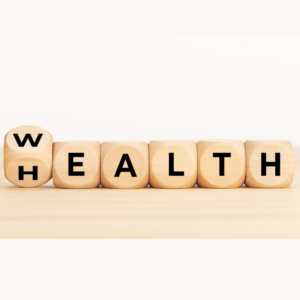 In my former career, I worked in companies that managed investments for institutional pension funds. So I’m well aware of the importance of investing for retirement. It’s something I’m sure we all agree on. The idea is to save money (making wise investments to grow that money) so, when the time comes to retire, you have enough invested that you can live the way you want. Save money now so you have the money you want in retirement. Simple. Well, the same is true for your health. Invest in your health now, so you have the health you want in retirement.
In my former career, I worked in companies that managed investments for institutional pension funds. So I’m well aware of the importance of investing for retirement. It’s something I’m sure we all agree on. The idea is to save money (making wise investments to grow that money) so, when the time comes to retire, you have enough invested that you can live the way you want. Save money now so you have the money you want in retirement. Simple. Well, the same is true for your health. Invest in your health now, so you have the health you want in retirement.
And we all want the most bang for our buck, right? Well, in terms of return on investment, there’s not much that can beat regular exercise. So my advice is to invest in exercise for a healthy retirement. And just as any amount of nutritious, home-cooked food is an improvement on a junk food diet, any amount of exercise is better than sitting all day.
Let’s take the investment analogy a little further and consider how financial planning is done. You make some educated estimates of your expected lifespan and how much capital you will require for annual expenses throughout that time. And then you work backwards to calculate how much you need to be putting in the bank now in order to have the bank balance you’ll need in the future. You have to think the same way in terms of your health. Especially when you consider some hard facts about aging like the ones I’ve listed below, courtesy of Peter Attia, MD and his newly released book “Outlive: The Science & Art of Longevity“. As Dr. Attia is both eloquent and succinct, I have taken the liberty of quoting liberally from his book here.
Aerobic fitness – the lower it goes, the less you can do
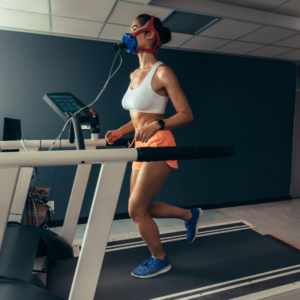 We measure aerobic fitness using a metric called VO2 max. This is the maximum (max) rate (V) of oxygen (O2) your body is able to use during exercise. I won’t go into the specifics of how it’s measured but it usually involves a lot of hard work on a treadmill with a mask strapped to your face. But you might be interested to know that a 2018 study in JAMA that followed more than 120,000 people found that “someone of below average VO2 max for their age and gender…is at double the risk of all-cause mortality compared to someone in the top quartile”. Even more to the point, this level of poor cardiorespiratory fitness “carries a greater relative risk of death than smoking.” Wow.
We measure aerobic fitness using a metric called VO2 max. This is the maximum (max) rate (V) of oxygen (O2) your body is able to use during exercise. I won’t go into the specifics of how it’s measured but it usually involves a lot of hard work on a treadmill with a mask strapped to your face. But you might be interested to know that a 2018 study in JAMA that followed more than 120,000 people found that “someone of below average VO2 max for their age and gender…is at double the risk of all-cause mortality compared to someone in the top quartile”. Even more to the point, this level of poor cardiorespiratory fitness “carries a greater relative risk of death than smoking.” Wow.- “It’s striking how VO2 max declines with age, and how this decline corresponds to diminished functional capacity. The lower it goes, the less you can do.” Dr. Attia uses the following examples: “a thirty-five-year-old man with average fitness for his age – a VO2 max in the mid-30s – should be able to run at a ten-minute mile pace….But by age seventy, only the very fittest 5 percent of people will still be able to manage this. Similarly, an average forty-five- to fifty-year-old will be able to climb stairs briskly (VO2 max = 32), but at seventy-five, such a feat demands that a person be in the top tier for their age group”.
Muscle mass declines precipitously after age 65
- Muscle mass declines “steeply after about age sixty-five and, then….It’s as if people just fall off a cliff sometime in their mid-seventies. By age eighty, the average person will have lost 8 kilograms of muscle, from their peak”.
- “A ten-year observational study of roughly 4,500 subjects ages fifty and older found that those with low muscle mass were at 40 to 50 percent greater risk of mortality than controls, over the study period.”
- Worse, “we lose muscle strength about two to three times more quickly than we lose muscle mass. And we lose power (strength x speed) two to three times faster than we lose strength.”
The other sad truth is that we can lose muscle mass and strength far more quickly and easily than we are able to gain it. Especially if we lead sedentary lives. And it gets even harder as we age.
Bone density declines along with muscle mass
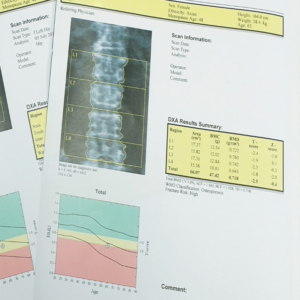 Bone density “diminishes on a parallel trajectory to muscle mass, peaking as early as our late twenties before beginning a slow, steady decline. For women, this decline happens much more quickly when they hit menopause, if they are not on HRT.”
Bone density “diminishes on a parallel trajectory to muscle mass, peaking as early as our late twenties before beginning a slow, steady decline. For women, this decline happens much more quickly when they hit menopause, if they are not on HRT.”- This combination of loss of muscle and strength and poor bone density puts us at much higher risk of fracture. This is a serious concern as “the mortality from a hip or femur fracture is staggering once you hit the age of sixty-five. It varies by study, but ranges from 15 to 36 percent in one year – meaning that up to one-third of people over sixty-five who fracture their hip are dead within a year. Even if a person does not die from the injury, the setback can be the functional equivalent of death in terms of how much muscle mass and, hence, physical capacity is lost during the period of bed rest”.
The more active you want to be as you age, the more you need to train for it now
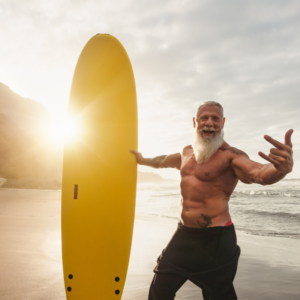 And so, back to our analogy. Just as we want to retire with sufficient capital to support us for the duration of our lives, we want to reach older age with enough aerobic fitness, muscle mass/strength and resilient bone mass banked in our bodies. In this way, we can prevent injury and continue to pursue the activities we enjoy.
And so, back to our analogy. Just as we want to retire with sufficient capital to support us for the duration of our lives, we want to reach older age with enough aerobic fitness, muscle mass/strength and resilient bone mass banked in our bodies. In this way, we can prevent injury and continue to pursue the activities we enjoy.
Dr. Attia says it best. “The more active you want or plan to be as you age, the more you need to train for it now.” Exercise has superpowers. And it offers an excellent return on your investment.
Exercise offers an excellent return on your investment
Here are some encouraging points (also gleaned from Dr. Attia’s book) about what exercise can do for you:
- “Going from zero weekly exercise to just ninety minutes per week can reduce your risk of dying from all causes by 14 percent. It’s very hard to find a drug that can do that.”
- “Increasing your VO2 max makes you functionally younger. One study found that boosting elderly subjects VO2 max by…about 25%, was equivalent to subtracting twelve years from their age….VO2 max can always be improved by training, no matter how old you are.”
- “Study after study has found that regular exercisers live as much as a decade longer than sedentary people.”
- Remember the precipitous decline in muscle mass mentioned above? Well, “those who maintain higher activity levels lose much less muscle, more like three to four kilograms on average” (as opposed to eight).
- Exercise not only allays or reverses physical decline, it can do the same for cognitive decline as well. Dr. Attia believes exercise is the single most powerful intervention to reduce the risk of dementia and Alzheimer’s disease. It does this largely by by improving both blood sugar control and the brain’s vascular system.
- Numerous studies have shown exercise to be effective also in reducing the risk of other major chronic diseases, such as type 2 diabetes, heart disease and cancer.
It’s never too late to start an exercise program
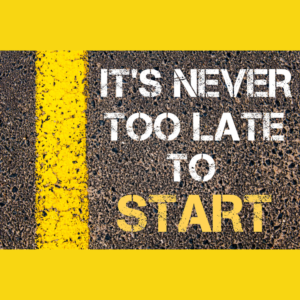 I’m the first to admit that it takes hard work to improve your fitness. Not to mention time. As my husband jokingly said to me after eking out time in a busy day for a strength workout, “Wow, it takes a non-zero amount of time to keep fit!” But I can’t imagine a better reward. While it’s best to start investing in exercise as early as you can, it’s never too late to exercise (click here for some inspiration). And although adding muscle mass may prove difficult if you are more advanced in years, strength training will help stave off its loss and improve muscle strength in the muscle you have, which is equally important.
I’m the first to admit that it takes hard work to improve your fitness. Not to mention time. As my husband jokingly said to me after eking out time in a busy day for a strength workout, “Wow, it takes a non-zero amount of time to keep fit!” But I can’t imagine a better reward. While it’s best to start investing in exercise as early as you can, it’s never too late to exercise (click here for some inspiration). And although adding muscle mass may prove difficult if you are more advanced in years, strength training will help stave off its loss and improve muscle strength in the muscle you have, which is equally important.
Your physical balance is as important as your bank balance
Remember to include balance and stability training. They are also key to preventing injury and reducing fracture risk. After all, with better balance and stability, you are less likely to fall in the first place. Try this self-assessment: stand with one foot in front of the other and try to balance. Now close your eyes and try it again. How long you can hold steady? Can you do it for ten seconds? If not, you might want to (re)read my post on how to Better Your Balance.
Health is wealth
Your body is one of your most valuable assets. You only get one and it has to serve you all your life, so treat it right. How would you would treat your car if you knew you could never have another? And that it has to last as long as you do? You can read my post about this here. It’s another persuasive analogy.
I’ll leave you with a final bit of wisdom from Dr. Attia. “It is much better to save and invest and plan ahead, letting your wealth build gradually over decades, than to scramble to try to scrape together an individual retirement account [just before retiring] and hope and pray the stock market gods help you out.”
If you are inspired to fit more exercise into your day, remember to progress gradually to prevent injury. If you are just beginning, it is wise to consult with a fitness professional to ensure your program is suited to you/your goals and that you are doing your exercises correctly. Should you have underlying health conditions, speak with your doctor about what is appropriate for you.
I really enjoyed Dr. Attia’s book. As well as exercise, his book explores nutritional biochemistry, sleep and the importance of emotional health as tactics we can use to improve our lifespan and, more importantly, healthspan. I highly recommend it.